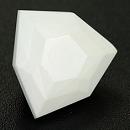|
|
||||||||||||||||
|
||||||||||||||||
|
||||||
|
|
|
|
Bakerite
|
|
| | |
| Discovered in 1903; IMA status: Valid (pre-IMA; Grandfathered) | ||
|
| ||
|
Chemistry |
|
|
| |
|
Ca4B4(BO4)(SiO4)3(OH)3 • H2O | |
|
|
Hydrated Calcium Boro-silicate Hydroxide |
|
Molecular Weight: |
623.65 gm |
|
Composition: |
Calcium |
25.71 % |
Ca |
35.97 % |
CaO |
|
|
Silicon |
13.51 % |
Si |
28.90 % |
SiO2 |
|
|
Boron |
8.67 % |
B |
27.91 % |
B2O3 |
|
|
Hydrogen |
0.81 % |
H |
7.22 % |
H2O |
|
|
Oxygen |
51.31 % |
O |
|
|
|
|
|
100.00 % |
|
100.00 % |
= TOTAL OXIDE |
|
|
|
||||
|
Classification |
|
|
| |
|
Silicates (Germanates) | |
|
8/B.29-20 | |
|
|
9 : SILICATES (Germanates)
|
|
Related to: |
Gadolinite-Datolite Group. |
|
Members of Group: |
Gadolinite-Datolite Group: Bakerite, Calciogadolinite-(Y), Calcybeborosilite-(Y), Datolite, Gadolinite-(Ce), Gadolinite-(Y), Hingganite-(Ce), Hingganite-(Y), Hingganite-(Yb), Homilite, Minasgeraisite-(Y) |
|
Varieties: |
None |
|
Synonyms: |
None |
|
|
|
|
Crystal Data |
|
|
|
|
|
Rarely as single crystals, to 0.2 mm, stout, rhombic prisms having oblique terminations or as thin diamond-shaped tablets. As botryoidal and drusy crusts and nodules; most commonly as dense fine-grained aggregates or massive. |
|
|
None |
|
|
|
|
|
Physical Properties |
|
|
|
|
|
None |
|
|
Irregular/Uneven |
|
|
Brittle |
|
|
4.5 |
|
|
2.88 (g/cm3) |
|
|
None |
|
|
Not Radioactive |
|
|
|
|
|
Optical Properties |
|
|
|
|
|
Colorless to white |
|
|
Translucent to Opaque from clay inclusions |
|
|
Vitreous to Porcelaneous |
|
|
1.624 - 1.654 Biaxial ( - ) |
|
|
0.030 |
|
|
Weak |
|
|
None |
|
|
|
|
|
Occurances |
|
|
|
|
|
Geological Setting: |
As irregular veins in altered volcanic rock (Baker Canyon, Death Valley, California, USA). |
|
Common Associations: |
Natrolite, Thomsonite (Baker Canyon, Death Valley, California, USA); Danburite, Calcite, Stilbite, Datolite, Quartz (Charcas, Mexico) |
|
Common Impurities: |
None |
|
Type Locality: |
Corkscrew Canyon Mine (Corkscrew Mine), Corkscrew Canyon, Black Mts, Furnace Creek District (Furnace Creek Borate District), Death Valley National Park, Inyo Co., California, USA |
|
Year Discovered: |
1903 |
|
View mineral photos: | |
|
|
|
|
More Information |
|
|
|
|
|
| |
|
|
|
|
Distribution:
In the USA, in California, the mineral probably never
occurred at the type locality given as "16 miles
northeast of Daggett" which is Borate, 14 km east
of Yermo, San Bernardino County; it more likely was
from later authenticated localities in the Black Mountains,
west of Furnace Creek, Death Valley, Inyo County; also
in the Sterling Borax mine, Tick Canyon, Los Angeles
County. Found near Tory Hill, Bancroft, Ontario, Canada.
At Charcas, San Luis Potosí, Mexico. From Sivas, Turkey.
In Italy, from near Sestri Levante, Liguria. |
|
|
We
have not photographed our Bakerite gems yet. Please
check back soon. |
